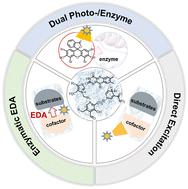利用天然酶进行新自然不对称光生物转化的最新进展
Organic chemistry frontiers : an international journal of organic chemistry
Pub Date : 2025-04-15
DOI:10.1039/d5qo00470e
引用次数: 0
摘要
光生物催化结合了可见光催化和酶催化的优点,已成为不对称合成的关键工具。在过去的十年里,几种天然存在的酶被重新用于催化各种非自然的转化,这些转化是众所周知的难以用传统方法实现的。这篇新兴评论着重于从2022年到2024年12月发表的光生物催化的进展,并重点介绍了与第一次演示相关的早期开创性报告。本文综述了可见光与酶的耦合模式,包括通过酶的电子供体-受体配合物照射的净还原光酶催化(通常),通过酶的直接可见光激发的氧化还原中性光酶催化,以及协同双光/酶催化。在每个部分中,讨论按酶的类型进行分类,强调潜在的机制方面,进化轨迹和代表性底物范围。我们期待这一综述将对光生物催化的进一步发展和应用产生启发。本文章由计算机程序翻译,如有差异,请以英文原文为准。

Recent advances in repurposing natural enzymes for new-to-nature asymmetric photobiotransformations
Photobiocatalysis, which integrates the strengths of visible-light-catalysis and enzymatic catalysis, has established itself as a pivotal tool for asymmetric synthesis. Over the past decade, several naturally occurring enzymes have been repurposed to catalyze diverse unnatural transformations that are notoriously difficult to realize using traditional methods. This emerging review focuses on the advancements in photobiocatalysis published from 2022 to December 2024 and also highlights earlier seminal reports related to the first demonstration. We organize this review by the coupling modes of visible-light and enzymes, including net-reduction photoenzymatic catalysis (typically) through the illumination of enzymatic electron donor–acceptor complexes, redox-neutral photoenzymatic catalysis via direct-visible-light excitation of enzymes, and synergistic dual photo-/enzymatic catalysis. With each section, the discussion is categorized by the type of enzyme, emphasizing the underlying mechanistic aspects, evolutionary trajectories and representative substrate scopes. We anticipate that this review will inspire further developments and application of photobiocatalysis.
求助全文
通过发布文献求助,成功后即可免费获取论文全文。
去求助
来源期刊
CiteScore
7.80
自引率
0.00%
发文量
0

 求助内容:
求助内容: 应助结果提醒方式:
应助结果提醒方式:


